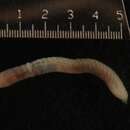en
names in breadcrumbs


Thoracopheliaare burrowing deposit feeders, generally found in the mid- to upper intertidal areas of sandy intertidals.Thoracopheliaare characterized by having the body divided into three distinct body regions: (1) a head, (2) a swollen thoracic region, and (3) a longer narrower posterior region containing a ventral groove and branchiae. A lateral notopodial ridge or row of papillae separates the thoracic and posterior regions at the 10th chaetiger in all species (Blake, 2000; Santos et al., 2004).
Thoracophelia spp. can be distinguished by branchial structures, such as the three species found in North America: T. mucronata (Treadwell, 1914) is found along the west coast of North America and T. dillonensis (Hartman, 1938) and T. williamsi (Hartman, 1938) are found in central California (Law et al., 2013).
The genus Thoracophelia Ehlers, 1897, was recently revalidated by Blake (2011) and replaced genus Euzonus Grube 1866.